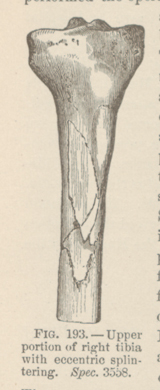Title: Vezina, O.
Source text: The Medical and Surgical History of the War of the Rebellion. (1861-65.), Part 3, Volume 2 (Washington, DC: Government Printing Office, 1883), 279.
Civil War Washington ID: med.d2e11832
TEI/XML: med.d2e11832.xml
CASE 460.—Private O. Vezina, Co. B, 9th New Hampshire, aged 24 years, was wounded at Tolopotomy Creek, May 31, 1864, and admitted to the field hospital of the 2d division, Ninth Corps, where Surgeon J. Harris, 7th Rhode Island, noted: "Shot wound of right leg by minié ball." Four days after the reception of the injury the man was transferred to Douglas Hospital, Washington, where the limb was amputated. Assistant Surgeon W. Thomson, U. S. A., who performed the operation, described the case as follows: "The missile entered over the anterior surface of the tibia at about the junction of the lower thirds, passed obliquely upward and inward, fracturing the bone in several pieces and lodging beneath the integuments, whence it was extracted on the field. The fibula was not injured. On admission, the leg was erysipelatous and abscesses were burrowing above and below, one of which was opened below the internal malleolus. Poultices were applied, and several sloughs of the integuments came away, leaving the muscles and tendons exposed. The patient suffered constitutional irritation from continual pain and was anxious for amputation, which was performed on June 11th, by the antero-posterior flap method, at the lower part of the middle third. The stump was dressed with equal parts of tincture of opium and tincture of camphor, and poultices were applied until June 18th, when the sloughs had entirely separated. After this, cold-water dressings were used and the stump progressed finely. By September 1st, it had been healed for some time, with the exception of a fistulous opening leading to necrosed bone. On October 13th, the patient having for some days suffered from great pain and consequent inability to rest, a sequestrum, six inches long and of a nearly entire circumference, was, with great difficulty, removed by Acting Assistant Surgeon H. Gibbons. A large formation of new bone was discovered around the cavity thus left in the stump. After the operation the pain ceased, and the patient again became cheerful and his appetite good. On December 25th, the opening had almost entirely closed." The upper portion of the tibia of the amputated limb, showing eccentric splintering by the missile, and necrosis adjacent to the seat of the fracture, was contributed by the operator, and is represented in the wood-cut (FIG. 193). The sequestrum, shown opposite (FIG. 194), was contributed by Assistant Surgeon W. F. Norris, U. S. A. The patient was discharged from service June 14, 1865, and furnished with an artificial limb one month afterwards by B. F. Palmer, of Philadelphia. The pensioner was paid June 4, 1878.

